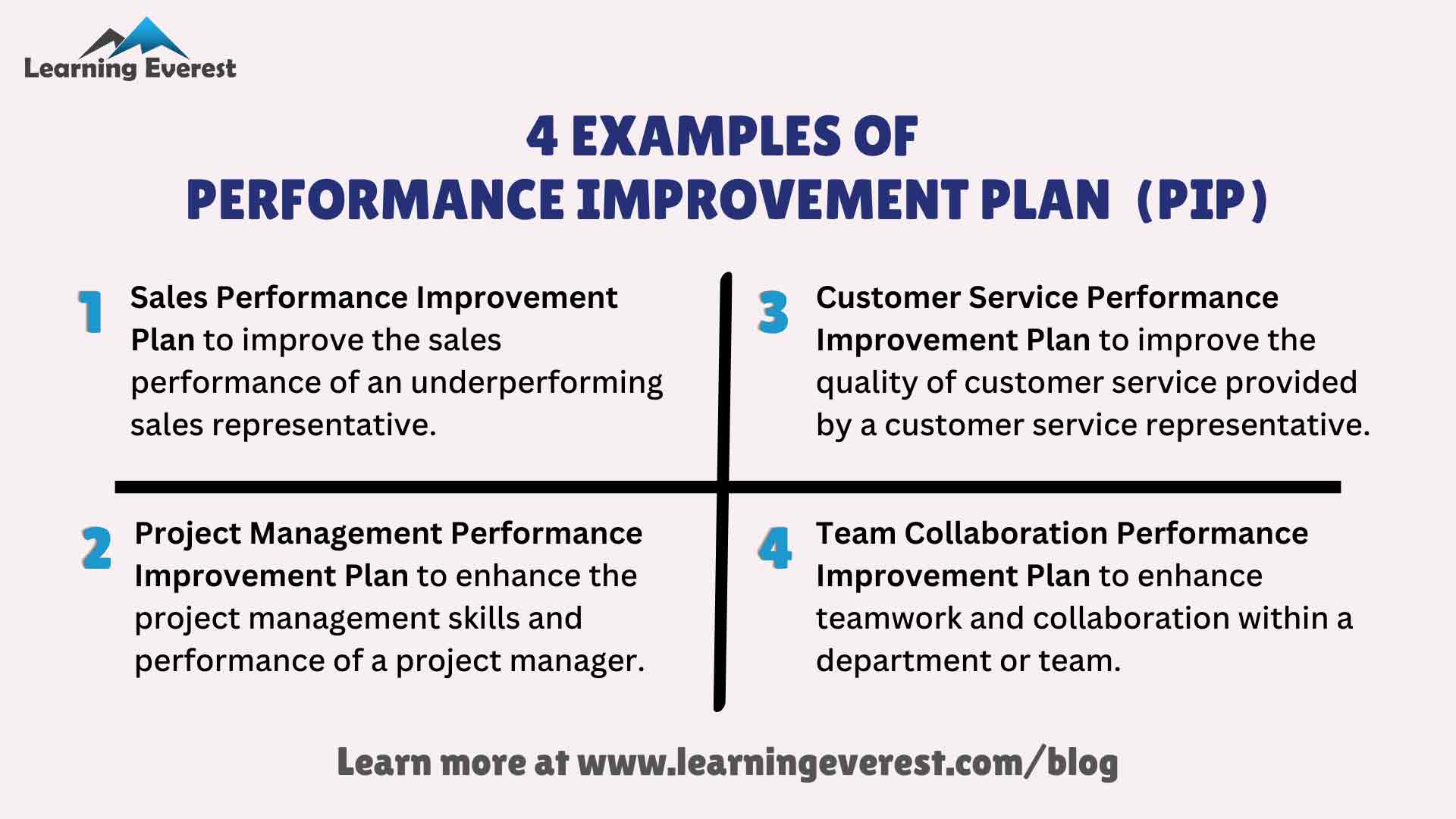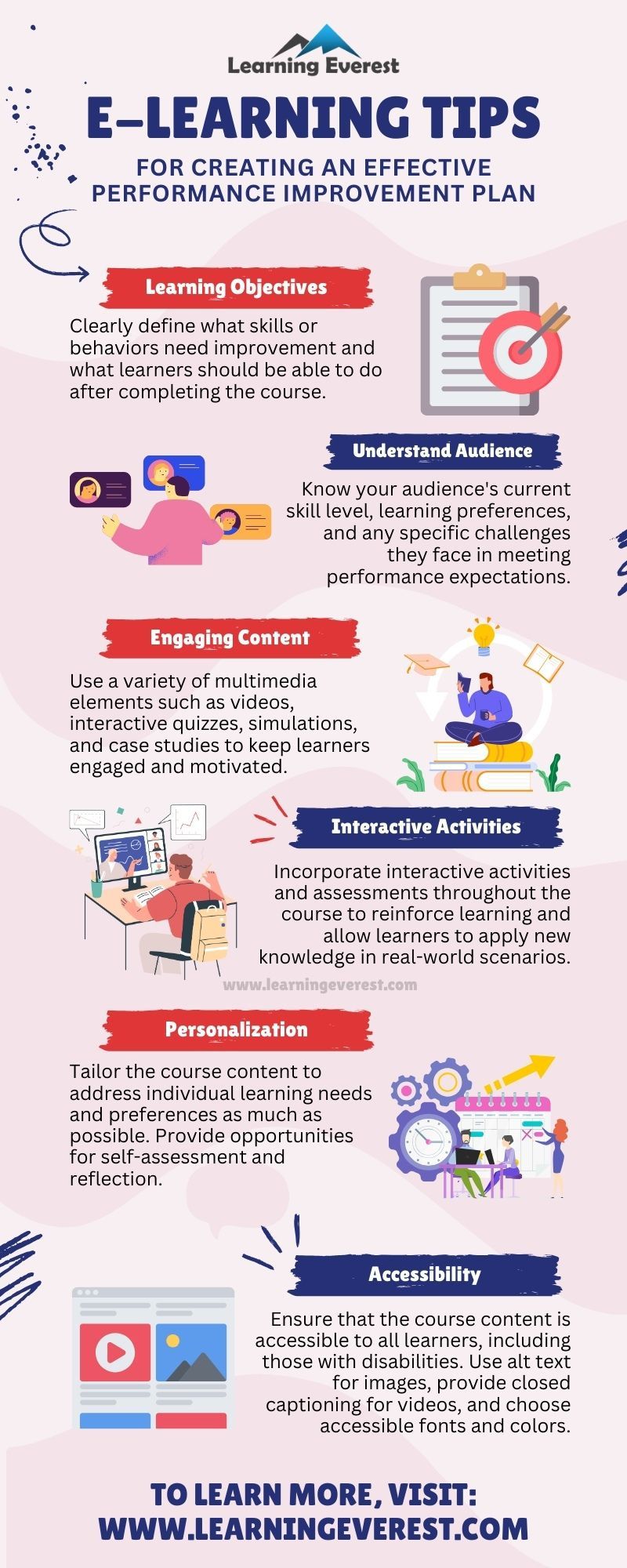In today’s modern corporate world, organizations are continuously seeking advanced strategies to deal with the improvement of employee performance and their overall productivity as an organization. One such avenue is the integration of e-learning methodologies into performance improvement plans. In this blog, we’ll delve into the role of e-learning in the performance improvement plan and the emerging trends and technologies in e-learning that can revolutionize traditional performance improvement plans and enhance the employee development process.
Let’s begin!
Table of Contents
- What is a performance improvement plan (PIP)?
- When should you implement a performance improvement plan?
- What are the benefits of a performance improvement plan?
- How do you create an effective Performance Improvement Plan (PIP) through e-learning?
- Several emerging trends and technologies in e-learning
- Conclusion
- Infographic
- Knowledge Check!
- Frequently Asked Questions (FAQs)
- 1. What are performance improvement plans?
- 2. Does PIP lead to termination?
- 3. What is an example of a PIP?
What is a performance improvement plan (PIP)?
A performance improvement plan (PIP) is a document that provides performance goals for the employee so they have targets to work toward as they change their behavior and, as a result, advance their career. Performance improvement plans aren’t necessarily negative. Instead, they help improve employees’ productivity and performance by providing detailed feedback.
The criteria for successfully completing a performance improvement plan can include goals such as undertaking additional training, attending frequent manager meetings, or achieving better metrics for key performance indicators (KPIs). You can structure each to fit the needs of your team, organization, and the individual employee.
When should you implement a performance improvement plan?
Performance improvement plans work best when someone on your team is struggling with one or more tasks. Signs of underperformance can include a decrease in productivity or engagement or a recent drop in performance.

performance improvement plan
What are the benefits of a performance improvement plan?
Here are a few benefits of a performance improvement plan:
1. Promotes a positive company culture
Employees succeed when they know their expectations and are held accountable for their performance. Performance improvement plans can reinforce a positive company culture, where employees know they will be supported if they are struggling or need more guidance to progress in their careers. Moreover, by focusing on the positive—what it takes to improve—rather than criticizing the negative, a PIP can alleviate feelings of defensiveness.
2. Helps employees feel cared for
When employers take the time to prepare a PIP and outline the specific areas for improvement or steps for advancement, employees feel cared for and supported. Moreover, it shows employees that managers are willing to take the time necessary to provide direct feedback and guidance rather than leaving it up to the employees to draw their own conclusions.
3. Saves time and resources
It takes considerable time and money to go through the hiring process and onboarding of a new employee. For this reason, employers may want to offer underperforming employees a chance to improve performance. This can be especially accurate if the employee has good “soft skills”—such as friendliness, patience, and a good attitude—but needs help with specific work-related skills, such as learning to use new software.
Moreover, working with the employee to design the plan and discussing areas for improvement in detail can make a PIP more successful. It shows that you recognize the employee’s challenges. Having a plan also helps prevent litigation if the employee’s performance doesn’t improve and you must dismiss them.
How do you create an effective Performance Improvement Plan (PIP) through e-learning?
Creating a performance improvement plan (PIP) through e-learning streamlines the process and ensures clear communication and accountability. Here’s a structured approach to developing a PIP via e-learning:
1. Conduct a training needs analysis
Most organizations find it challenging to plan training programs – it is hard to decide which training is the most important. By using a training needs analysis, you will be able to determine the training that needs to be completed as soon as possible and which training program can be left till later in the year. A training needs analysis is an excellent tool for discovering your team’s weaknesses and areas for strengthening or reskilling. The process helps determine where the L&D team should distribute a training budget for PIP and finds areas where they need additional assistance to retain what they have learned.
2. Integrate e-learning modules
After completing the training needs analysis, the next step is to integrate e-learning modules tailored to address those specific skill gaps and knowledge deficiencies identified in the assessment phase. An e-learning module can cover a wide range of topics, such as productivity tools, software proficiency, time management, and interpersonal skills. You can tailor-made training according to your needs and efficiency. E-learning gives you the flexibility to train anyone from anywhere in a cost-effective manner. Moreover, you can also opt for ready-made, off-the-shelf courses to upskill your employees fast. To learn more, contact us.
3. Monitor progress
E-learning platforms often incorporate progress-tracking features. These can include monitoring completed modules, quizzes, assignments, and overall course progression. Progress tracking helps learners and instructors assess performance, identify areas for improvement, and adjust learning strategies accordingly. You can establish milestone checkpoints at regular intervals (e.g., 30, 60, and 90 days) to assess improvement and provide feedback. Implement an LMS or eLearning platform to deliver training materials, track employee participation, and monitor progress. LMS platforms offer features such as course completion tracking, assessment tools, and reporting capabilities to evaluate employee performance systematically.
4. Provide feedback and support
Feedback plays an important role in the learning and development process by providing learners with valuable insights into their progress, performance, and areas for improvement. Therefore, try to offer ongoing feedback and encouragement to keep the employee motivated and engaged utilizing e-learning resources. Additional support can also be given through various online resources.
5. Evaluate Employee Performance
Evaluating employee progress using eLearning involves leveraging digital tools and platforms to assess performance, track learning outcomes, and measure skill development. Design performance-based assessments or simulations that allow employees to apply newly acquired knowledge and skills in real-world scenarios. Performance assessments enable a more holistic evaluation of employee competencies and capabilities beyond traditional knowledge-based assessments.
Several emerging trends and technologies in e-learning
Several emerging trends and technologies in e-learning to revolutionize traditional performance improvement plans (PIPs):
Adaptive learning platforms
Adaptive learning platforms adapt training content as preferred by each employee to address specific skill gaps identified in PIPs effectively. It uses data analytics and algorithms to personalize learning experiences based on individual learner needs. AI-powered analytics tools can also be integrated to analyze learner data to identify trends, patterns, and areas for improvement.
Microlearning
Microlearning is a short-term curriculum-based learning approach to work-based skills and techniques. It is also a training strategy that delivers training units and concentrates on quality rather than quantity. These include crash courses, infographics, short videos with explainers, interactive quizzes, or flashcards. Microlearning is a way of training and delivering training content to learners in bite-sized modules at the point of need, with a focused and specific training outcome.
The learner is in full control of what they are learning and can complete their training at a time and place that suits their busy schedule. This approach is useful for busy employees who may struggle to find time to complete lengthy training sessions. You can integrate microlearning modules into PIPs to provide targeted instruction on specific skills or knowledge areas that are hitherto missing.
Gamification
Gamification in eLearning uses gaming principles and critical elements to meet the required learning objectives. Gamification techniques leverage people’s basic desires for interaction, learning, mastery, competition, achievement, rank, self-expression, altruism, or closure. Gamification uses rewards for players who accomplish desired tasks or competitions to engage players. Types of rewards include points, badges, levels, progress bars, or providing the player with virtual currency. Making the achievements for accomplishing tasks visible to other players or providing leaderboards encourages players to compete.
Virtual Reality (VR) and Augmented Reality (AR)
VR and AR technologies foster an immersive learning environment that simulate real-world scenarios and provide a sense of hands-on training experiences. Immersive learning creates experiences in the form of scenarios that are relevant to people. AR and VR technologies are particularly valuable for training employees in technical skills or high-stakes situations where mistakes can be costly or even life-taking. Integrating VR and AR into your traditional PIPs can offer employees a safe space to practice and refine their capabilities.
Mobile Learning
Mobile learning lets employees access training materials and resources anytime, from anywhere, using their smartphones or tablets. This flexibility enables employees to engage with PIPs at their own pace and convenience, increasing accessibility and participation rates. Therefore, using a mobile learning feature while providing PIPs can give your employees the benefit of flexibility and your organization the benefit of cost-effectiveness.
By leveraging these emerging trends and technologies in e-learning, organizations can modernize traditional PIPs, improve employee performance, and create a culture of continuous learning and development.
Conclusion
Performance improvement plans can be an effective management tool if used correctly and under the right circumstances. Businesses typically use them to help employees understand that they are not meeting the expectations of the role and to give them a path to improvement. For employers, it serves to help retain staff, and for employees, it provides the opportunity to understand and overcome their shortcomings within the role.
Infographic

E-Learning Tips for Creating an Effective Performance Improvement Plan
Knowledge Check!
Frequently Asked Questions (FAQs)
1. What are performance improvement plans?
A performance improvement plan (PIP) is a document that provides performance goals for employee so they have targets to work toward as they change their behavior and, as a result, advance their career.
2. Does PIP lead to termination?
No, a PIP doesn’t necessarily lead to termination. It is designed to provide employees with clear expectations and support to help them improve their performance.
3. What is an example of a PIP?
An example of a PIP typically includes a detailed description of the performance issues or areas needing improvement.





